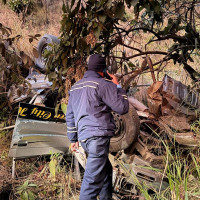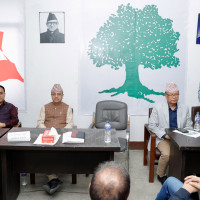- Monday, 5 January 2026
Can BIMSTEC Substitute SAARC?
The sixth summit meeting of the Bay of Bengal Initiative for Multi-Sectoral Cooperation (BIMSTEC) was held on April 3-4 in Thailand with a declaration seeking to further foster integration and cooperation among members. The meeting in itself is a positive sign at a time when other regional organisations are faltering. The initiatives and resolve to promote cooperation among countries are good and positive.
Regionalism and regional integration were once a general trend in the world, especially after World War II. Devastated by the war, the Western European countries realised the necessity of working together for the reconstruction of war-ravaged infrastructures, accelerating economic development. With this realisation, European countries paved the ground for creating a regional group in Europe. As a result, France, West Germany, Italy, Luxembourg, Belgium, and the Netherlands met in Paris, France, in 1951 and signed a treaty agreeing to establish the European Coal and Steel Community (ECSC), perhaps the world’s first example of regionalism.
Common good
Its objective was to integrate their economies and collectively work for the common good by pooling their resources, especially coal and steel, which were the primary products of that time. The ECSC later evolved into the European Economic Community (EEC) in 1957 and finally into the European Union (EU) in 1992 through the Maastricht Treaty. The European Union is taken as a model of the most successful regional organisation in the world. This gave rise to a new trend in international relations marked by growing regionalism with a flurry of different regional organisations coming into existence.
The European Union, Council of Europe, European Political Community, Eurasian Economic Union, Union for the Mediterranean, African Union, Arab League, Arab Maghreb Union, Association of South East Asian Nations ( ASEAN) , Gulf Cooperation Council in the Middle East, South Asian Association for Regional Cooperation (SAARC), Caribbean Community, Shanghai Cooperation Organisation (SCO) Asian African Legal Consultative Organisation, and Union of South American Nations are some of the regional organisations that sprouted, seeking to promote regional cooperation and integration. However most of these organisations are yet to realise their stated objectives owing to narrow national interests of member countries, geopolitical factors and the role and pressure of external powers.
When the regional integration was in vogue, it was the period of bi-polar world in which the United States and former Soviet Union were steeply vying for enlarging their sphere of influence and contain one another in different parts of the world. The two super powers accordingly formed alliances of different kinds in all continents and devised strategies and counterstrategies against one another. Such alliances were guided mostly by strategic and military purpose while a few by economic considerations.
The alliances of strategic nature included North Atlantic Treaty Organisation (NATO) and Warsaw Pact in Europe, Central Treaty Organisation or Bagdad Pact in Asia, South East Asia Treaty Organisation (SEATO) in South East Asia, Australia-United Kingdom-US alliance or AUKUS and Quadruple Security Dialogue of the United States, Australia, Japan and India are some of the grouping of security and strategic nature. The SEATO and CENTO no longer exist now as their relevance ceased to exist. The SEATO was disbanded soon after the Vietnam War while CENTO ceased to exist after the Iranian Revolution and fall of Shah Regime in Teheran.
Inspired by the success of European Economic Community (EEC), several new regional organisations came in existence. The Association of South East Asian Nations (ASEAN) was created in 1967 by Indonesia, Malaysia, the Philippines, Singapore, and Thailand. The primary objective of this regional organisation is more political and ideological than economic. These countries came together to primarily withstand the communist influence as Soviet Union was enlarging its influence in the region especially after Vietnam backed by Moscow helped install Pol Pot’s regime in Cambodia. Economic integration was only the façade. Although the ASEAN lost its relevance after Khmer Rouge were pushed out of power, the organisation has concentrated on economic cooperation and has continued to prove its worth.
Once vibrant regional organisation the SAARC has been in moribund state. SAARC came into existence in 1985 at the height of the Cold War for regional integration of seven South Asian countries — Nepal, India Bhutan, Bangladesh, Pakistan, Sri Lanka and the Maldives. Afghanistan joined only in 2007. SAARC process has recently stalled due mainly to the long-held animosity and conflict between India and Pakistan. Right from the beginning, India was apprehensive about the SAARC. New Delhi took the SAARC as South Asian countries’ attempt to gang up against India. The SAARC process has not moved ahead since 2014. The last summit of the SAARC was held in Kathmandu and Nepal resumed its chair.
As per the SAARC charter, summit has to be held in every two year. The 19th SAARC Summit was to be held in Pakistan in 2016. But SAARC summit has not been held for more than a decade owing to India’s refusal to participate in Islamabad Summit. SAARC is defunct and a sub-regional cooperation framework of Bangladesh, Bhutan, India and Bhutan (BBIN) was mooted as SAARC’s alternative. However, BBIN has limited space and does not cover entire South Asia. Similarly BIMSTEC has got priority from South Asian countries especially India as an alternative to the SAARC. BIMSTEC is regional organisation of seven countries of South Asia and South East Asia including Nepal, India, Bangladesh, Bhutan, Sri Lanka, Thailand and Myanmar.
Connectivity
Nepal, India, Bhutan, Bangladesh and Sri Lanka are South Asian and Thailand and Myanmar are South East Asian countries. BIMSTEC is less homogenous as its members have different aspirations and orientations. Thailand and Myanmar seek more connectivity and integration with ASEAN and East Asian countries than with South Asian nations. BIMSTEC, thus, may not take SAARC’s place. Thus, both BBIN and BIMSTEC cannot be alternatives to SAARC.
SAARC is in a coma but is still breathing faintly. This situation occurred right after Nepal assumed its chair, which is unfortunate. However, there is little scope for Nepal to do anything because SAARC came into the diplomatic crossfire between India and Pakistan. Now the time has come to decide whether it should be declared dead or an alternative arrangement worked out to revive it. For this, one alternative could be to hold the SAARC summit in Kathmandu in the model of the UN General Assembly meeting, which is held in New York where the headquarters is located. This may help revive the SAARC process for which the provision of the SAARC Charter needs to be amended.
(The author is former chief editor of this daily and former ambassador. lamsalyubanath@gmail.com)






-original-thumb.jpg)









